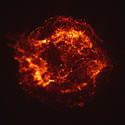
Image credit: Hubble
Just in case you were worried, it appears that a supernova would have to be really really close to the Earth before it could cause massive damage to our environment. Scientists at NASA and Kansas University used data from a recent exploding star to determine that a supernova would have to be only 26 light-years away in order to strip away the ozone layer – an encounter that only happens once every 670 million years.
We have one less thing to worry about. While the cosmic debris from a nearby massive star explosion, called a supernova, could destroy the Earth’s protective ozone layer and cause mass extinction, such an explosion would have to be much closer than previously thought, new calculations show.
Scientists at NASA and Kansas University have determined that the supernova would need to be within 26 light years from Earth to significantly damage the ozone layer and allow cancer-causing ultraviolet radiation to saturate the Earth’s surface.
An encounter with a supernova that close only happens at a rate of about once in 670 million years, according to Dr. Neil Gehrels of NASA’s Goddard Space Flight Center in Greenbelt, Md., who presents these findings today at the American Astronomical Society meeting in Seattle.
“Perhaps a nearby supernova has bombarded Earth once during the history of multicellular life with its punishing gamma rays and cosmic rays,” said Gehrels. “The possibility for mass extinction is indeed real, yet the risk seems much lower than we have thought.”
The new calculations are based largely on advances in atmospheric modeling, analysis of gamma rays produced by a supernova in 1987 called SN1987a, and a better understanding of galactic supernova locations and rates. A supernova is an explosion of a star at least twice as massive as our Sun.
Previous estimates from the 1970s stated that supernovae as far as 55 light years from Earth could wipe out up to 90 percent of the atmosphere for hundreds of years. The damage would be from gamma rays and cosmic rays, both prodigiously emitted by supernovae. Gamma rays are the most energetic form of light. Cosmic rays are atomic particles, the fastest-moving matter in the Universe, produced when the expanding shell of gas from the exploded star runs into surrounding dust and gas in the region. Gamma rays, moving at light speed, would hit the Earth’s atmosphere first, followed closely by the cosmic rays moving at close to light speed.
Gamma-ray light particles (called photons) and the cosmic-ray particles can wreak havoc in the upper atmosphere, according to Dr. Charles Jackman of NASA Goddard, who provided the atmospheric analysis needed for the new calculation.
The particles collide with nitrogen gas (N2) and break the molecule into highly-reactive nitrogen atoms (N). The nitrogen atoms then react fairly quickly with oxygen gas (O2) to form nitric oxide (NO) and, subsequently, other nitrogen oxides (NOx). The nitrogen oxide molecules can then destroy ozone (O3) through a catalytic process. This means that a single NOx molecule can destroy an ozone molecule and remain intact to destroy hundreds of more ozone molecules.
The new calculations — based on the NASA Goddard two-dimensional photochemical transport model — show that a supernova within 26 light years from Earth could wipe out 47 percent of the ozone layer, allowing approximately twice the amount of cancer-causing ultraviolet radiation to reach the Earth’s surface. Excessive UV radiation is harmful to both plants and animals, thus a doubling of UV levels would be a significant problem to life on Earth.
The gamma-ray irradiation would last 300 to 500 days. The ozone layer would then repair itself, but only to endure cosmic-ray bombardment shortly after, lasting at least 10 years. (Cosmic rays are electrically charged particles whose paths are influenced by magnetic fields, and the extent of such fields in the interstellar medium is not well understood.)
The calculations simultaneously point to the resilience of the ozone layer as well as its fragility in a violent Universe, said Dr. Claude Laird of the University of Kansas, who developed the gamma-ray and cosmic ray input code and performed the atmospheric model simulations. Although the ozone layer should recover relatively rapidly once the particle influx tapers off — within about one to two years, the Goddard models show — even this short period of time is sufficient to cause significant and lasting damage to the biosphere.
“The atmosphere usually protects us from gamma rays, cosmic rays, and ultraviolet radiation, but there’s only so much hammering it can take before Earth’s biological defenses break down,” he said.
Dr. John Cannizzo of NASA Goddard and University of Maryland, Baltimore Country, initiated and coordinated the new calculations. “I’ve long been fascinated by the possibility of extinction from something as remote as a star explosion,” he said. “With this updated calculation, we essentially worked backwards to determine what level of ozone damage would be needed to double the level of ultraviolet radiation reaching the Earth’s surface and then determined how close a supernova would need to be to cause that kind of damage.”
These results will appear in the Astrophysical Journal 2003, March 10, vol. 585. Co-authors include Barbara Mattson of NASA Goddard (via L3 Com Analytics Corporation) and Wan Chen of Sprint IP Design in Reston, Virginia.
Original Source: NASA News Release
